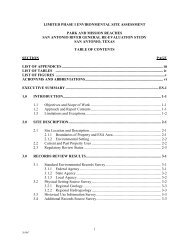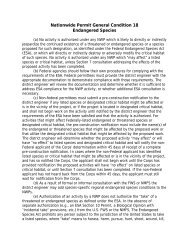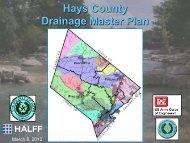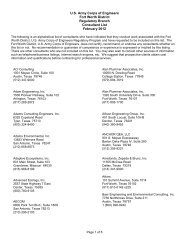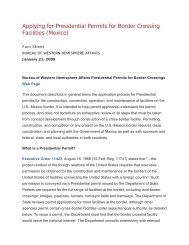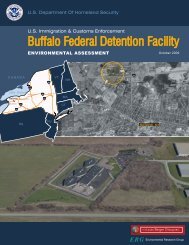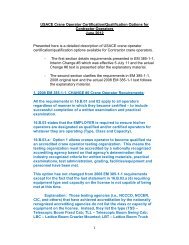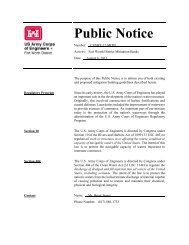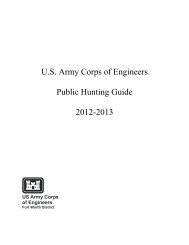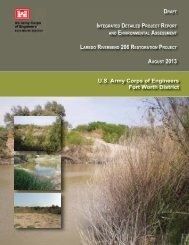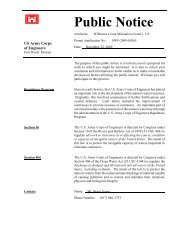environmental assessment us border patrol, tucson sector
environmental assessment us border patrol, tucson sector
environmental assessment us border patrol, tucson sector
Create successful ePaper yourself
Turn your PDF publications into a flip-book with our unique Google optimized e-Paper software.
3-1712345678910111213141516171819202122232425262728293031323334353637383940414243444546the migratory flyway would be minor and would not affect s<strong>us</strong>tainability of migratory birdpopulations in the region. The communications tower and buildings could provide raptor perchand nesting sites, but BMPs, including anti-perching devices, could be <strong>us</strong>ed to discourage thisactivity. The Proposed Action would, however, have a long-term, minor adverse effect onmigratory birds.Conservation measures listed below would reduce disturbance and loss of wildlife habitats. The Migratory Bird Treaty Act (16 U.S.C. 703-712, [1918, as amended 1936, 1960,1968, 1969, 1974, 1978, 1986 and 1989]) requires that Federal agencies coordinate withthe USFWS if a construction activity would result in the take of a migratory bird. Ifconstruction or clearing activities are scheduled during nesting seasons (March 15through Aug<strong>us</strong>t 31), surveys will be performed to identify active nests. Anotherconservation measure that would be considered is to schedule all construction activitiesoutside nesting seasons, negating the requirement for nesting bird surveys. To prevent entrapment of wildlife species during construction, CBP will cover allexcavated, steep-walled holes or trenches more than 2 feet deep at the end of eachworking day with plywood or provide these holes with escape ramps of earth fill orwooden planks. Biological monitors will thoroughly inspect all holes and trenches fortrapped animals, and if animals are present, no construction can resume until the animalsare out of the pit or trench. Biological monitors will check under construction equipment for wildlife species (e.g.,desert tortoise) prior to moving equipment that has sat idle for more than 1 hour.3.6.2.3 Alternative 2The permanent loss of approximately 10 acres of wildlife habitat at the Alternative 2 site wouldresult in impacts similar to those described for the Preferred Alternative.3.6.2.4 Alternative 3The permanent loss of approximately 10 acres of wildlife habitat at the Alternative 3 site wouldresult in impacts similar to those described for the Preferred Alternative.3.6.2.5 Alternative 4Minimal new construction and ground disturbance would occur under Alternative 4, and existingwildlife habitat would not be altered. However, the Proposed Action would require artificiallighting around the perimeter of the proposed FOB, and lighting would attract or repel vario<strong>us</strong>wildlife species within the project area. Likewise, periodic noise from helicopter takeoff andlanding from the proposed FOB would have minimal and intermittent impacts on thesurrounding wildlife communities. There is a possibility that the proposed communication towercould pose hazards to migratory birds and even some bird mortality; however, since the towerwould not <strong>us</strong>e guy wires, the potential for adverse impacts is greatly reduced. The existing stickbuiltnest on the windmill at the Alternative 4 site would be removed outside of the nestingseason to eliminate potential nest <strong>us</strong>e by raptors. Therefore, impacts on wildlife from Alternative4 would be similar to those described for the Preferred Alternative.Douglas FOB EADraftAug<strong>us</strong>t 2011



